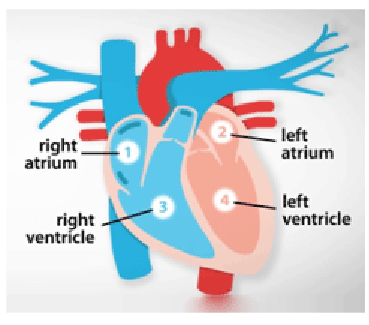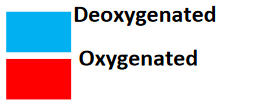What is the circulatory system?
The circulatory system is made up of the heart, lungs and blood vessels. Arteries carry oxygenated blood from the heart to the rest of the body. Veins carry deoxygenated blood from the body to the heart. Nutrients, oxygen and carbon dioxide are exchanged via the capillaries.
Diagram—The Heart
The heart is composed of four chambers; the right atrium, the right ventricle, the left atrium and the left ventricle.

The rate that your heart pumps is called your pulse.

The Function of the Heart
- Deoxygenated blood flows into the heart from the body through the veins.
- This blood is pumped out of the lungs through the pulmonary artery
- Blood is then the oxygenated in lungs
- Blood returns to the heart through the pulmonary cycle.
- The oxygenated blood is then pumped out of the heart through the aorta.
- The blood travels around the body delivering oxygen and nutrients to the organs.
Healthy Diet & Lifestyle
Things that can harm the circulatory system
- Smoking and drinking alcohol can be harmful to our health.
- Tobacco can cause short-term effects such as shortness of breath and loss of taste and long term effects such as lung disease and cancer.
- Alcohol can cause short term effects such as addiction and long term effects such as organ damage and cancer.
Things that can maintain a healthy circulatory system
Exercise helps to improve health by:
- Removing fatty deposits from the body.
- Toning muscles and reducing fat.
- Increasing fitness (ability to do high intensity activities
Focus Scientist
Barbara Casadei – a researcher helping The British Heart Foundation find cures for cardiovascular conditions.

Key Vocabulary
arteries: tubes in your body that carry oxygenated blood from your heart to the rest of your body.
atrium: the part of the heart that receives blood from the veins.
blood vessels: narrow tubes that your blood flows through.
carbon dioxide: a gas produced by animals and people breathing out.
circulatory system: the system responsible for circulating blood through the body, that supplies nutrients and oxygen to the body and removes waste products such as carbon dioxide.
deoxygenated: blood that does not contain oxygen.
*heart: the organ in your body that pumps blood around the body .
*lungs: two organs in your chest which fill with air when you breathe in. They oxygenate the blood and remove carbon dioxide from it.
*nutrients: substances that help animals and plants grow.
*organ: a part of the body that has a particular purpose and performs specific functions.
*oxygen: a colourless gas that plants and animals need to survive.
oxygenated: blood that contains oxygen.
pulse: the regular beating of blood through your body. How fast or slow your pulse rate is depends on how active you are.
respiration: inhaling oxygen-rich air and exhaling air filled with carbon dioxide.
veins a tube in your body that carries deoxygenated blood to your heart from the rest of your body.
ventricle the part of the heart from which blood passes into the arteries.
* vocabulary that I know from years 3&4. Definitions contain more complex explanations.